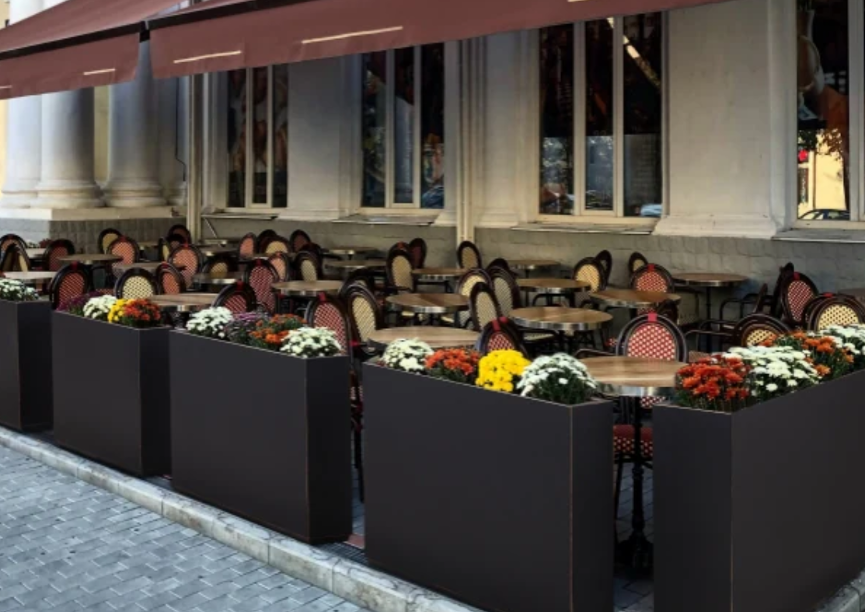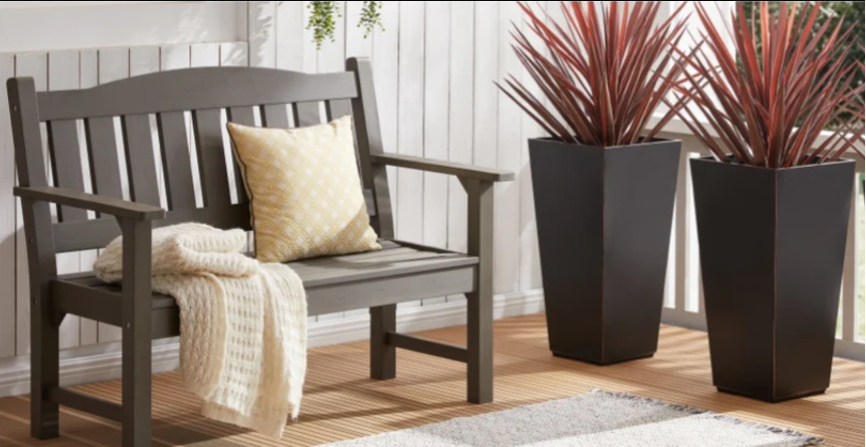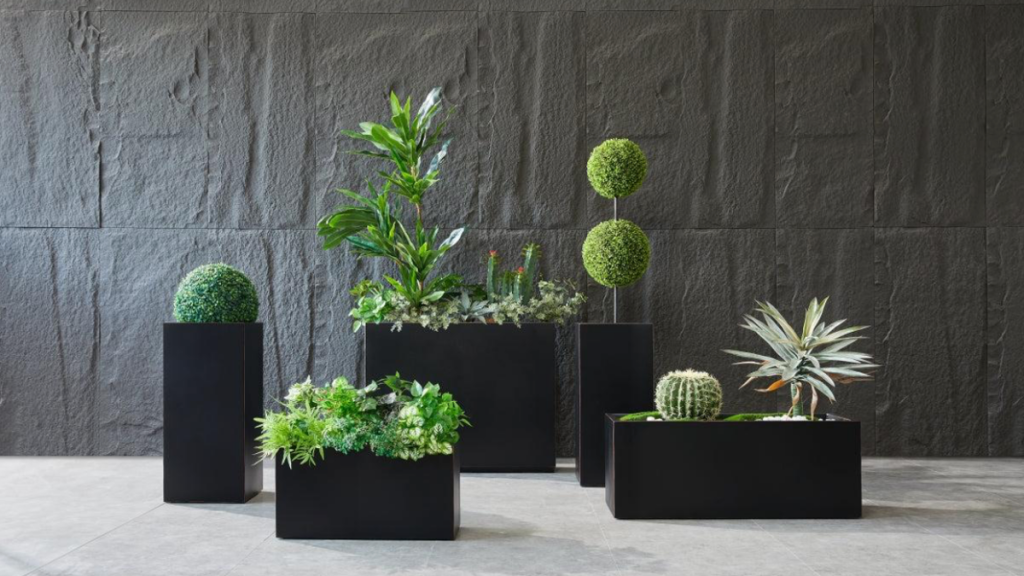The modern garden and interior design landscape is seeing a surge in popularity for square planters. These geometric beauties are not just a trend; they offer a unique blend of functionality and aesthetic appeal that complements a variety of design styles. Square planters bring a structured elegance to outdoor spaces and indoor corners, enhancing the visual interest with their clean lines and bold presence.
The Role of Square Planters and Their Characteristics
Square planters are characterized by their equal sides and right angles, which not only provide a striking look but also offer efficient space utilization. They are known for their generous soil capacity, allowing for robust root development and supporting a variety of plant types.
What’s more, outdoor square planters offer the ease of arrangement in patios and gardens, with their uniform shape fitting neatly into corners and along walls. Maintenance is simplified as the uniformity allows for a systematic approach to care.
Selecting and Using Square Plant Pots
The selection of square plant pots is are strategic decision that can elevate the functionality and visual appeal of your green spaces, both indoors and out.
1. Choosing the Right Square Plant Pot
Selecting the perfect square plant pot for your space involves thoughtful consideration of several factors:
- Space Constraints: Measure the area where you plan to place the planter. This will help determine the appropriate size that will fit without overwhelming the space or appearing too small.
- Aesthetic Preferences: Consider the style of your garden or home decor. Square planters come in a variety of materials and finishes, from sleek stainless steel to rustic wood, and each can significantly alter the ambiance of the area.
- Plant Needs: The type of plants you intend to grow will also influence your choice. Some plants require more sunlight, while others need shade. The drainage capabilities of the planter material and the depth of the soil it can hold are also important.
- Durability and Weather Resistance: If the planter will be outdoors, choose materials that can withstand the elements. Ceramic and metal are generally more durable and weather-resistant than plastic.
- Portability: If you plan to move your planters around, lightweight materials like plastic or fiberglass are easier to handle.
2. Using Different Materials for Square Plant Pots
Each material brings unique benefits to the table:
- Plastic: Inexpensive, lightweight, and available in a range of colors and designs. It’s easy to clean and maintain but may not be as durable as other materials.
- Ceramic: Offers a classic, timeless look with a wide variety of glaze options. However, it’s more fragile and heavier than plastic.
- Metal: Provides a modern, industrial feel and is quite durable. It can be prone to rust if not properly coated or treated.
- Wood: Gives a natural, warm appearance and can be stained or painted to match any decor. It requires more maintenance to prevent rot and pests.
3. Creative Layouts with Square Planters
Arranging square planters can be an exciting exercise in design:
- Symmetrical Arrangements: Placing square planters in pairs or rows can create a formal, balanced look, which is especially effective in minimalist or contemporary settings.
- Corner Decorations: Utilize the corners of your garden or room with square planters to maximize space and draw attention to underused areas.
- Color Coordination: Choose plants and planters that harmonize with the surrounding colors. Complementary hues can create a vibrant look, while monochromatic schemes offer a calming, unified feel.
- Layering: Use planters of different heights to create visual interest. Tall planters can anchor the arrangement, while shorter ones can be used to fill in gaps or create a cascading effect.
- Themed Displays: Create a thematic display by choosing plants that complement each other, such as those with similar colors, textures, or growth habits.
- Functional Placement: Consider the function of the space when arranging planters. In a dining area, for example, use planters to create an intimate setting without obstructing the view or encroaching on the dining space.
- Seasonal Variations: Change the arrangement according to the season. In the spring and summer, opt for bright, flowering plants. In the fall and winter, switch to evergreens or plants with colorful foliage.
By carefully selecting and arranging your square plant pots, you can create a living piece of art that not only beautifies your space but also serves as a reflection of your personal style and love for nature.

Plant Selection and Pairing with Square Planters
Square planters are versatile and can accommodate a wide array of plants. Annuals and perennials thrive in their ample space, while herbs and vegetables benefit from the good drainage square pots often provide. For a vertical element, vines can be trained to climb trellises placed within or beside the planters. Bulbs also favor the deep soil of square planters, offering a spectacular display when in bloom.
Matching the light, water, and soil requirements of plants with the characteristics of the square planters is crucial. For instance, plants that require full sun should be placed in south-facing locations, while those needing less light can be situated in shadier spots.
Maintenance and Care of Decorative Planters
The beauty and functionality of decorative planters extend beyond their initial setup, requiring a commitment to ongoing care that ensures both the planters and the plants within them flourish for seasons to come.
Water Management
Water is a critical component of plant health. Here’s how to manage it effectively:
- Monitoring Moisture Levels: Use your finger to check the soil moisture. For most plants, the top inch of soil should be allowed to dry out before watering again.
- Drip Irrigation Systems: Consider installing a drip irrigation system for consistent watering without over-saturating the soil.
- Watering Timing: Water early in the morning to reduce evaporation and to give the plants time to absorb water before nightfall.
Soil Care
Healthy soil is the foundation for thriving plants:
- Soil Replacement: Over time, the nutrients in the soil get depleted. Replace the soil in your planters annually or as needed based on plant health.
- Soil Quality: Use a high-quality potting mix that provides good drainage and aeration. Consider adding compost or slow-release fertilizers to enrich the soil.
- pH Balance: Regularly check the pH level of your soil and adjust it as necessary. Most plants prefer a slightly acidic to neutral pH.
Seasonal Care
Seasonal changes require different care approaches:
- Winter Protection: In colder climates, protect planters and plants from freezing temperatures. You can use insulating materials or move sensitive planters indoors.
- Summer Sun: During the hot summer months, ensure plants have adequate water and consider providing some shade during the hottest part of the day.
Cleaning and Sanitizing
Keeping your planters clean is important for preventing diseases:
- Routine Cleaning: Regularly remove dead leaves, flowers, and debris from the planters to prevent mold and pests.
- Deep Cleaning: At the end of each growing season, thoroughly clean the planters. Use a mild bleach solution or a commercial cleaner to sanitize the pots.
Plant Health Monitoring
Regularly check on your plants for signs of stress:
- Pest Checks: Look for signs of pests or diseases on a regular basis. Early detection can make treatment easier and more effective.
- Nutrient Deficiency: If plants show signs of nutrient deficiency, such as yellowing leaves or stunted growth, consider adding a balanced fertilizer.
By implementing the practices outlined above, you not only preserve the beauty and utility of your decorative planters but also create a nurturing environment for your plants to grow and thrive, reaping the rewards of your horticultural endeavors.

Wallowa Design’s Square Planters
Integrating Wallowa Design’s square planters into your outdoor or indoor space is adding a decorative element.
Wallowa Design’s Square Planter Features
- Drainage Solutions: These planters come with pre-drilled drainage holes that are strategically placed to prevent overwatering, ensuring the health of your plants and reducing the risk of root rot.
- Durable Construction: Made from high-grade metal and coated with special outdoor baking paint, Wallowa Design’s planters are built to last. They are resistant to cracks, fading, and UV damage and can withstand extreme temperatures ranging from -20 to +120 degrees Celsius.
- Variety of Sizes and Colors: Wallowa Design offers a range of sizes and colors to suit different customer needs and preferences. The main colors for their large planter box include black, espresso, white, and gray.
Incorporating Wallowa Design’s Square Planters into Your Space
- Outdoor Living Spaces: Use Wallowa Design’s square planters to add a touch of nature to your patio or deck. Their durable metal construction is perfect for withstanding the elements, while their modern design complements contemporary outdoor furniture and decor.
- Indoor Decor: Inside, these planters can serve as a stylish base for your favorite indoor plants, enhancing the ambiance of your living room, kitchen, or office space.
- Commercial Applications: In commercial settings like restaurants, hotels, or office buildings, Wallowa Design’s planters can serve as attractive dividers or focal points that add a layer of sophistication and greenery.
By choosing Wallowa Design’s square planters, you’re not just selecting a container for your plants; you’re making a statement about your commitment to quality, style, and the enduring beauty of well-crafted outdoor living.
Conclusion
Square planters are a versatile and stylish choice for garden and interior design enthusiasts. Their ability to blend form and function makes them a popular choice for both casual green thumbs and professional landscapers. With the right selection, arrangement, and care, square planters can transform your space into a green haven that is as practical as it is beautiful.

